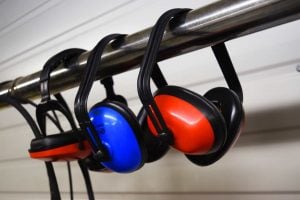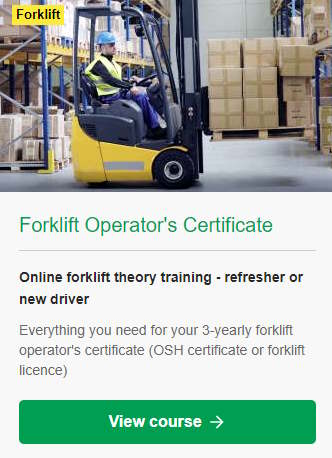Some forklift trainers will tell you that it is dangerous to wear earplugs or other hearing protection while using a forklift because you can’t hear other forklifts or pedestrians around you, but forklifts can create a lot of noise. High levels of noise exposure will eventually cause hearing loss. Long periods of even moderate noise exposure have an adverse effect on health and can cause fatigue, tinnitus (ringing in the ears), stress, anxiety, gastrointestinal problems and high blood pressure. These can lead to problems sleeping, which causes further fatigue. All operators, drivers and managers should do a fatigue management course to help manage sleepiness and fatigue in the workplace.
Large diesel forklifts can be as loud as 100dB which is about as loud as a noisy lawnmower. LPG forklifts sit around 75-85dB. Quieter electric forklifts can be as low as 60dB (which is the same as background music) but tend to be between 65-75dB. However, none of these readings include the horn or any audible warning when reversing which averages out at 85dB – about the same volume as a food blender!
85dB is the recommended maximum continuous noise exposure in an 8-hour shift, but the risk of hearing damage still occurs at that level and international guidelines say 75dB, which is perceived to be half as loud as 85dB, is a safe level. Numerous sources state 84dB as a typical operating volume for petrol or diesel-powered forklifts.
What should you do if you have a noisy forklift and/or warehouse environment?
WorkSafe says that it’s not acceptable to rely on hearing protection alone and that a workplace should endeavour to reduce the level of noise using other means before resorting to ear protection as a final measure.
- Forklift drivers should never be allowed to listen to music on personal headphones while using the forklift.
- Are the muffler (silencer) and anti-vibration mountings working well on the forklift and has the forklift been tuned recently?
- Are there any loose components on the forklift which should be fixed so that they don’t contribute rattles and squeaks to the overall noise level?
- If pedestrian safety is an issue in noisy places, can you separate where your pedestrians are allowed by building walkways with fencing? Check out our pedestrians vs forklifts safety guide here.
- Is the equipment in your workplace functioning correctly and does it need to be turned on all the time?
- Can you install acoustic screens around noisy machinery?
- Can you rotate jobs so that any one person isn’t exposed to loud noises for very long?
- Educate your team about noise exposure
If ear protection is required

Forklift drivers will eventually get used to wearing ear protection and will be able to pick out sounds within the work environment. It’s important to identify when and where ear protection should be worn and communicate those rules to your team. Ask the following questions:
- What sort of ear protection is the best for your workers in terms of the other personal protective equipment they will be using?
- Can you improve sight lines and overall visibility by adjusting racking position and installing convex mirrors at the ends of aisles?
- Should lights and rotating warning beacons be used all the time, even when visibility is good
- Is it worth purchasing ear protection that selectively blocks frequencies rather than protection that attenuates every frequency?
- Teach hand signals for communication with forklift drivers to every team member.

You may also want to add other signals for common tasks in your workplace.
Resources: WorkSafe Noise in the Workplace


